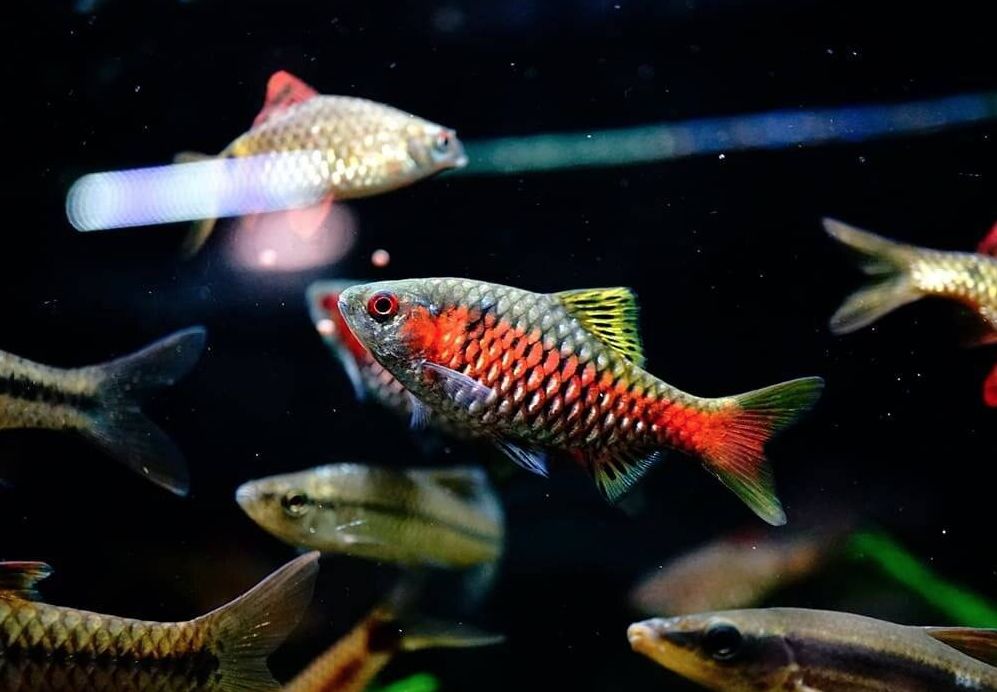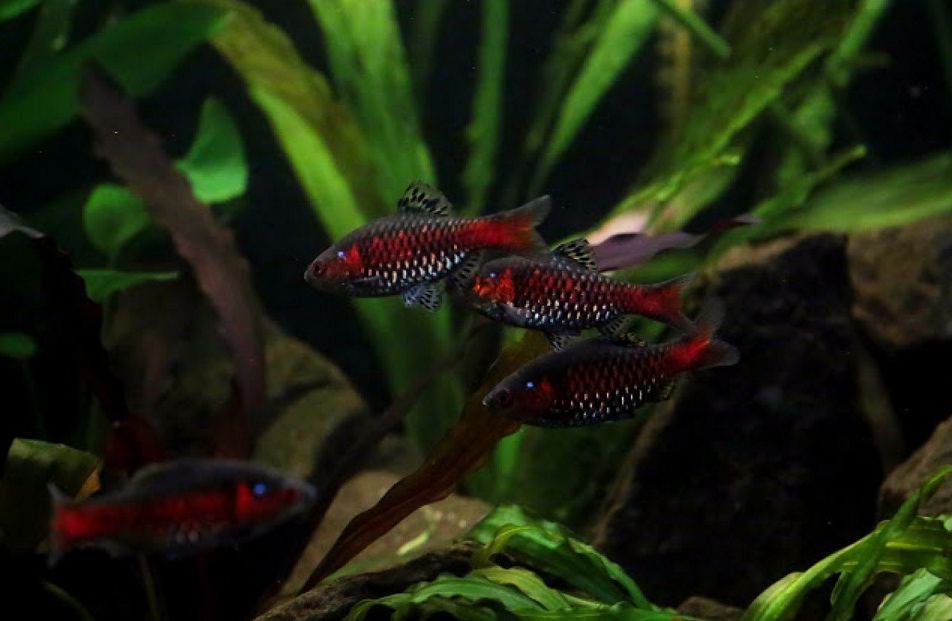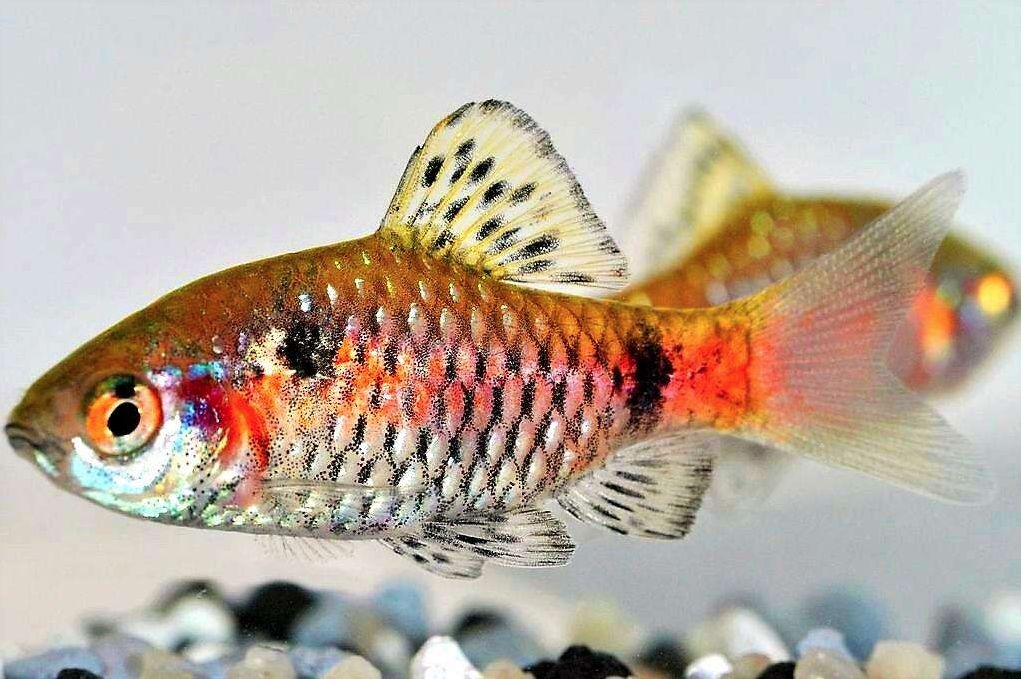The Odessa barb (Pethia padamya) is a small, vibrant fish known for its active behavior and striking appearance. Despite these appealing traits, it is less common in the aquarium trade compared to other barb species. Historically, the Odessa barb was thought to be a color variation of Puntius ticto; however, this classification was misleading since the natural coloration of Puntius ticto does not feature the distinctive wide red stripe along its body. This misconception was prevalent in aquarium literature until 2008, when Pethia padamya was officially recognized as a separate species. Understanding its unique classification and characteristics can help aquarists appreciate the Odessa barb’s place in the aquarium hobby.

Contents
Habitat in the wild
The Odessa barb (Pethia padamya) is a captivating species of tropical freshwater fish belonging to the family Cyprinidae, one of the largest families of freshwater fish, which includes carps, minnows, and barbs. The name ‘padamya’ comes from the Burmese word for ‘ruby,’ reflecting the fish’s vibrant coloration. Native to Myanmar, the Odessa barb can be found in the Irrawaddy River and its tributary, the Chindwin River, as well as in artificially impounded bodies of water.
In its natural habitat, the Odessa barb thrives in slow-moving or still waters such as rivers, streams, ponds, and marshes, typically in muddy-bottomed backwaters. The water is usually clear or slightly turbid, with temperatures ranging from 20 to 26 degrees Celsius (68 to 79 degrees Fahrenheit) and a pH level of 6.0 to 7.5, making it well-suited to the region’s tropical climate. Dense vegetation, submerged roots, and leaf litter provide ample hiding spots and exploration opportunities.
As omnivores, Odessa barbs feed on a variety of food sources in the wild, including small aquatic insects, crustaceans, algae, and plant matter. The name “Odessa barb” may have originated from its early popularity in Odessa, Ukraine, but the exact reason remains unclear. Understanding these aspects can enhance the appreciation and care for this vibrant species in the aquarium setting.

Description
The Odessa barb is a captivating species of tropical freshwater fish that appeals to aquarium enthusiasts for several reasons. Understanding their characteristics, habitat, and care needs can help aquarists provide the best environment for these vibrant fish.
Size
The Odessa barb typically grows to a maximum size of around 2.5 inches (6.5 cm) in length. This relatively small size makes them an excellent choice for aquarium enthusiasts, especially those with smaller tanks. While individual specimens may vary slightly in size, maintaining optimal conditions in a well-kept aquarium generally ensures they stay within this range. Their compact size allows for easy integration into community tanks, where they can thrive alongside other small fish.
Body and Color
The body of the Odessa barb is elongated and oval-shaped, flattened from the sides, and features a partially incomplete lateral line. They possess large scales and lack barbels. The back displays a foliage green hue, while the sides are silvery with a metallic sheen, and the abdomen is white. Dark spots near the tail fin and above the pectoral fins add to their striking appearance. Notably, the front spot takes on an elongated shape resembling a vertical stripe, and the scales form a clear reticulated pattern across the body.
Males are particularly vibrant, showcasing a wide, bright red stripe along their sides. Their dorsal, anal, and abdominal fins are adorned with black spots, further enhancing their visual appeal. In contrast, females display a much less pronounced stripe, making the males easier to identify.
Lifespan
In the wild, Odessa barbs typically have a lifespan of around 3 to 4 years. However, with proper care in a well-maintained aquarium, they can live longer—often reaching up to 5 years or even more. Factors such as water quality, diet, and tank conditions play crucial roles in extending their lifespan. Providing a balanced diet and maintaining optimal water parameters can significantly enhance their well-being and longevity.
| Characteristic | Description |
|---|---|
| Scientific Name | Pethia padamya |
| Common Names | Odessa Barb, Scarlet Barb |
| Family | Cyprinidae |
| Origin | Irrawaddy and Sittang river basins in Myanmar |
| Maximum Size | Up to 2.5 inches (6.5 cm) |
| Lifespan | 3 to 5 years (in proper aquarium conditions) |
| Temperament | Generally peaceful, but may exhibit fin-nipping |
| Tank Size | At least 20 gallons for a small group |
| Water Parameters | pH: 6.0 – 7.5, Temperature: 72°F – 79°F (22°C – 26°C) |
| Tank Level | Middle to upper water column |
| Diet | Omnivorous – accepts flake, pellets, and live/frozen foods |
| Tank Mates | Peaceful community fish (avoid fin nippers) |
| Breeding | Egg-scattering species, requires separate breeding tank |
| Coloration | Bright orange-red body with black markings and iridescent blue patches |
| Care Difficulty | Beginner-friendly with proper care |
Difficulties in keeping
The Odessa barb is quite undemanding and suitable even for beginning aquarists. Like all barb species, it thrives in clean, well-aerated water with a gentle water flow. Providing these conditions helps ensure their health and vibrant coloration, making them an excellent choice for those new to the aquarium hobby. Regular water changes and good filtration are key to maintaining a suitable environment for these lively fish.
Care and keeping in a tank
Tank Size
Odessa barbs are active swimmers and thrive in spacious environments, which help them feel comfortable and less stressed. To create an ideal habitat, it’s important not to overcrowd the tank with decorations. Instead, leave ample open space for swimming. Incorporating long-stalked and small-leaved plants along the tank’s perimeter can provide both shelter and a natural aesthetic. A roomy, densely planted tank with open swimming areas is highly desirable for these fish.
As a general guideline, a minimum tank size of 20 gallons is recommended for a small group of Odessa barbs. However, more space is always beneficial. Larger tanks not only provide additional swimming room but also help dilute waste and maintain stable water conditions. A 30-gallon or larger aquarium is even more suitable for a small group of Odessa barbs, promoting their health and activity levels.
It’s important to remember that Odessa barbs are social fish and prefer to be kept in groups of five or more. A larger group not only enhances their well-being but also minimizes any aggressive tendencies, allowing them to exhibit their natural behaviors more freely.
Water Parameters
Odessa barbs are generally undemanding in terms of water parameters, but maintaining the following conditions will promote their health:
- Temperature: 72°F – 79°F (22°C – 26°C)
- pH: 6.0 – 7.5
- Hardness: Soft to moderately hard water (4 – 15 dGH)
While these values serve as general guidelines, the most crucial aspect is to keep the water conditions stable. Sudden fluctuations in temperature or pH can stress the fish and increase their susceptibility to diseases.
Regular water changes are essential to maintaining water quality. Using a reliable water conditioner can also help stabilize parameters. Since tap water can vary significantly in pH and hardness depending on the source, it’s advisable to regularly test your aquarium water with a test kit to ensure it remains within suitable ranges for Odessa barbs.
Additionally, it is vital to cycle the aquarium before introducing any fish, including Odessa barbs. This process establishes a stable biological filtration system that can efficiently handle the waste produced by the fish, ensuring a healthy environment.

Tank mates
The Odessa barb is generally known for its peaceful temperament, making it one of the more amicable and community-friendly species among barbs. Their behavior, however, can be influenced by various factors such as tank size, water quality, and the presence of tank mates. Aquarists appreciate Odessa barbs for their undemanding and resilient nature. As peaceful schooling fish, they thrive best in groups of at least 5 to 6 individuals of the same species, ideally alongside other peaceful tank mates. Keeping them with long-finned fish is not advisable, as this can lead to stress and aggression.
A notable characteristic of all barb species, including the Odessa barb, is that they experience less stress when in larger numbers. In a well-structured group, they form a clear hierarchy, allowing the Odessa barb to display its full beauty and vibrant colors. When kept in pairs or small numbers, these fish may become more timid, and their natural behaviors, along with their stunning coloration, can go unnoticed.
In larger groups, Odessa barbs tend to be less aggressive and more focused on social interactions. Conversely, in smaller groups, they may display territorial behaviors or engage in chasing, particularly during breeding periods. This is crucial to consider, as a larger school not only minimizes aggression but also encourages more active and engaging behavior. To maintain their peaceful nature, it is recommended to keep Odessa barbs in groups of five or more. This not only reduces aggression but also promotes sociability among the fish. Adding plenty of hiding spots and visual barriers in the aquarium can further mitigate potential conflicts, creating a harmonious environment for all inhabitants.
Additionally, it’s important to avoid combining Odessa barbs with fin-nipping or aggressive species, as their long, colorful fins may make them targets. Ideal tank mates include other small, peaceful fish like tetras, rasboras, and certain types of catfish. When kept with compatible companions in a suitable environment, Odessa barbs are likely to exhibit their peaceful and active nature, making them a delightful addition to any community aquarium.
A school of barbs will look great together with its relatives — tiger barb, denison barb, cherry barb.
Here are some suitable tank mates:
- Harlequin Rasboras (Trigonostigma heteromorpha)
- Neon Tetras (Paracheirodon innesi)
- Ember Tetras (Hyphessobrycon amandae)
- Glowlight Tetras (Hemigrammus erythrozonus)
- Black Neon Tetras (Hyphessobrycon herbertaxelrodi)
- Cardinal Tetras (Paracheirodon axelrodi)
- Rummy Nose Tetras (Hemigrammus rhodostomus)
- Dwarf Gouramis (Trichogaster lalius or Trichogaster chuna)
- Sparkling Gouramis (Trichopsis pumila)
- Celestial Pearl Danios (Danio margaritatus)
- White Cloud Mountain Minnows (Tanichthys albonubes)
- Dwarf Rasboras (Boraras spp.)
- Endler’s Livebearers (Poecilia wingei)
- Guppies (Poecilia reticulata)
- Platies (Xiphophorus spp.)
- Corydoras Catfish (Corydoras spp. – pygmy cory, panda cory, adolfoi catfish)
- Otocinclus Catfish (Otocinclus spp.)
- Bristlenose Plecos (Ancistrus spp.)
You can’t keep the Odessa barb together with large and predatory fishes, for example, with rope fish, bichir since they will treat barb as food. Slow long-finned fishes are also unsuitable tank mates for this barb.
Remember, the temperament of individual fish can vary, so it’s always a good idea to research the specific needs and behavior of any potential tank mate before adding them to the same aquarium as your Odessa barbs. Providing adequate hiding spots and visual barriers in the aquarium can also help reduce stress and promote harmony among the different species.

Diet
In the wild, Odessa barbs feed on insects, their larvae, plant matter, and detritus. Fortunately, feeding them in an aquarium is straightforward, as they readily accept various types of food and do not require a specialized diet. However, it’s essential to provide a balanced diet that meets their nutritional needs for optimal health and vitality.
A suitable diet for Odessa barbs includes:
High-quality Flakes or Pellets: A staple diet of high-quality flake or pellet food formulated for tropical fish serves as a solid foundation. Choose products that contain a balanced mix of proteins, vitamins, and minerals to support their overall health and well-being.
Live and Frozen Foods: Supplementing their diet with live or frozen foods mimics their natural feeding habits and enhances their coloration and activity levels. Treats like brine shrimp, daphnia, bloodworms, and mosquito larvae are excellent choices. These foods are high in protein and fulfill their requirement for animal-based nutrients.
Algae-based Food: Incorporating algae-based foods, such as spirulina flakes or pellets, is beneficial for their health and digestion, providing essential nutrients and fiber.
When feeding Odessa barbs, it’s important to offer small portions multiple times a day rather than one large meal. This approach prevents overeating and helps maintain water quality. Any uneaten food should be promptly removed from the tank to avoid decomposition, which can negatively affect water parameters and the overall health of the aquarium.
Gender differences: male vs female
Gender dimorphism in Odessa barbs is expressed through size and body shape, allowing aquarists to differentiate between males and females with some attention to detail.
One of the most notable differences is size: males are often slightly smaller and more slender compared to females. However, this distinction may not always be obvious, particularly in well-fed and healthy specimens.
Coloration also plays a key role in identifying the sexes. During the breeding season or when in optimal conditions, male Odessa barbs tend to exhibit more vibrant and intense colors than females. Males often display brighter reds or oranges, especially on their bodies and fins, making them stand out in the aquarium.
Another distinguishing feature is belly coloration. Males may develop a more intense red or orange hue on their bellies during breeding, further highlighting their reproductive readiness.
Behavior can also provide clues to gender. During courtship and breeding, males often display more active and sometimes aggressive behavior as they compete for the attention of females. This behavior includes chasing and showing off their colors, which can be fascinating to observe.
It’s important to note that these differences can be subtle and may not be readily apparent in all individuals, especially when they are not in breeding condition. If you’re trying to determine the sex of your Odessa barbs, observing their behavior during the breeding season and looking for any noticeable color changes can be helpful. Understanding these nuances can enhance the aquarium experience and aid in creating a balanced community tank.
Breeding
The Odessa barb reaches reproductive maturity at around 5 to 6 months of age. During spawning, females can lay up to 200 eggs, which they deposit in clusters among small-leaved tank plants. The eggs typically remain in the egg stage for about a day, and the juveniles start swimming about three days later.
For successful spawning, a spacious tank is essential, as the fish spawn more efficiently in a school. A recommended male-to-female ratio is 1:2 to encourage breeding behavior. Before spawning, it’s advisable to separate the fish into different tanks for 1 to 2 weeks to prepare them for reproduction. Small-leaved plants should be added to the spawning tank to provide suitable areas for egg deposition.
Water conditions are crucial for spawning: the water should be soft (less than 8 °dH), and the optimal temperature is between 25 and 27 °C. Spawning typically begins in the morning and lasts for 3 to 4 hours. After spawning is complete, the adult fish should be removed from the tank to prevent them from eating the eggs.
For feeding the juveniles, start with infusoria and small microorganisms. As they grow, you can gradually introduce crustacean nauplii, cyclops, and small daphnia to ensure a well-rounded diet that supports their development. This careful approach to breeding and rearing will help ensure a healthy population of Odessa barbs in your aquarium.